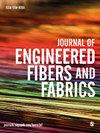纱间摩擦对不同织法机织物低速冲击响应的影响
IF 2.3
4区 工程技术
Q1 MATERIALS SCIENCE, TEXTILES
引用次数: 0
摘要
许多研究人员报道了纱线间摩擦对平纹织物对冲击的响应有重要影响。然而,纱线间摩擦对机织物与其他织物碰撞响应的影响尚未得到详细研究。本文采用数值分析方法,研究了纱线间摩擦对不同织型(平纹、2/2斜纹、2/2篮纹和3/1斜纹)机织物低速冲击响应的影响。纱线间摩擦和织物织物对低速冲击的响应都有很大影响。纱线间摩擦力越大,机织物冲击中心附近的拉应力集中程度越高,织物失效越早。此外,纱线间摩擦力越大,机织物中横向应力波的速度越高,冲击能量从织物的主纱到织物的次纱的分布越有效。虽然平纹织物的横向应力波速度最低,但由于纱线交织牢固,平纹织物的总吸能能力在不同织法的机织物中最高。另一方面,3/1斜纹布由于纱线交错松散,其总吸能能力在机织物中最低。本文章由计算机程序翻译,如有差异,请以英文原文为准。
Effects of inter-yarn friction on responses of woven fabrics with different weaves to a low-velocity impact
Many researchers have reported that inter-yarn friction has an important effect on the response of the plain-weave fabric to an impact. However, the effects of inter-yarn friction on impact responses of woven fabrics with other weaves have not been studied in detail. In the present work, numerical analysis was utilized to study the effects of inter-yarn friction on responses of woven fabrics with different weaves (the plain weave, 2/2 twill, 2/2 basket, and 3/1 twill) to a low-velocity impact. Both inter-yarn friction and the weaves of the woven fabrics greatly influenced the responses of the fabrics to a low-velocity impact. The higher the inter-yarn friction, the higher the levels of the tensile stresses concentrated near the centers of impact of the woven fabrics, and the earlier the failures of the fabrics. In addition, the greater the inter-yarn friction, the higher the velocities of the transverse stress waves in the woven fabrics, and the more effective the distributions of impact energy from the primary yarns of the fabrics to the secondary yarns of the fabrics. Although it had the lowest velocity of the transverse stress wave, due to its firmly interlaced yarns, the plain-weave fabric had the highest total energy absorption capacity among the woven fabrics with the different weaves. On the other hand, due to its loosely interlaced yarns, the 3/1 twill fabric had the lowest total energy absorption capacity among the woven fabrics.
求助全文
通过发布文献求助,成功后即可免费获取论文全文。
去求助
来源期刊

Journal of Engineered Fibers and Fabrics
工程技术-材料科学:纺织
CiteScore
5.00
自引率
6.90%
发文量
41
审稿时长
4 months
期刊介绍:
Journal of Engineered Fibers and Fabrics is a peer-reviewed, open access journal which aims to facilitate the rapid and wide dissemination of research in the engineering of textiles, clothing and fiber based structures.
 求助内容:
求助内容: 应助结果提醒方式:
应助结果提醒方式:


